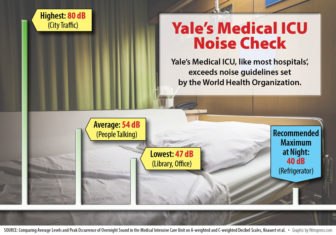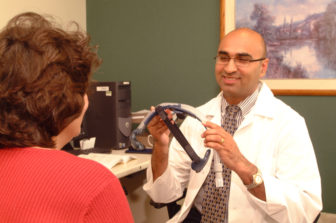Clattering carts, overly bright lights and frequent disruptions make hospitals a tough place to get a good night’s sleep.
But now, hospitals across Connecticut are launching efforts to help patients sleep longer and better.
 At Yale-New Haven Hospital, researchers are expanding a pilot program that successfully reduced noise in the medical ICU and kept staff out of patient rooms overnight.
At Yale-New Haven Hospital, researchers are expanding a pilot program that successfully reduced noise in the medical ICU and kept staff out of patient rooms overnight.
At Hartford Hospital, where noise levels sometimes resembled airport runways, they’ve eliminated overhead paging on patient floors except in true emergencies.
And Stamford Health’s new hospital building, slated to open in September, is designed with sleep in mind. Floors are sound resistant, windows are covered with blackout shades, and nurses stations have been decentralized to keep down conversations.
“We’ve really looked at how to best maximize the quietness of their environment,” said Ellen Komar, Stamford’s chief nursing officer and senior vice president for patient services.
There’s no question that sleep matters for recovery and health. Patients who don’t get enough sleep heal more slowly, have decreased immunity and pain tolerance, higher rates of anxiety, and are more likely to suffer from confusion and delirium.
Hospitals nationally are also waking up to the need to prioritize patient sleep as part of the broader shift toward patient-centered care, and also because of a federal program that penalizes hospitals for substandard performance scores in patient surveys.
Traditional nighttime and early morning interruptions to suit the schedules of busy labs and doctors are now seen as counter to the medical needs of patients.
“Is it really necessary to wake someone up at 5 o’clock to draw blood?” Komar asked rhetorically.
All Stamford patients now get a “Tuck Me In” toolkit, including a lavender-scented washcloth, earplugs, and the option of an evening hand massage. Lights are dimmed around 8 p.m., and patients are encouraged to tell their visitors to go home by 9, which can be a relief to exhausted patients and family members alike, Komar said.
Since implementing the changes a few years ago, patients are reporting more restful nights of sleep and using fewer pain medications, she said.
But change comes slowly.
At Hartford Hospital, where images of the night sky and a mock traffic light dubbed the “Yacker Tracker” remind staff and visitors to keep their voices down, officials admit that patients are still occasionally subjected to sounds as loud as a disco or nearby thunderclap.
Prioritizing sleep requires a sea change in the way nurses, doctors and support staff work, said Dr. Margaret Pisani, a critical care specialist who has been leading the sleep effort at Yale New Haven. Staff members are now being encouraged to consolidate their visits, moderate their hallway conversations and avoid flipping on all the lights when they walk into a patient’s room after dark.
The changes also required coordination with every hospital department from labs—which can’t process everyone’s specimens simultaneously—to respiratory therapy.
“You have to rethink the workflow and staffing and those kinds of things,” she said. She’s ran focus groups with night nurses and held conference calls with affiliated hospitals in Bridgeport and Greenwich so “they don’t have to reinvent the wheel.”

Photo Courtesy of Saint Francis Hospital.
Dr. Asher Quershi encourages staff at Saint Francis Hospital to dim lights by 9 p.m.
Although the science is clear that disrupted sleep is bad for hospital patients, it isn’t obvious precisely what affects people’s sleep, Pisani said. She and colleagues are still analyzing data they collected recently from noise and light level monitors that tracked every second in a number of rooms. They’re trying to answer questions like: What’s meaningful change in sound and light? Is this at a level that’s really going to disrupt someone or not? And are continuous loud noises the problem, or peaks in sound?
One down side to all this effort, Pisani noted, is that it can backfire with patients. Instead of seeing a staff that is respectful of sleep, some patients might feel neglected. So, Pisani has instructed nurses to tell patients: “We’ll be there if you need anything, but we’re not going to come in and out,” reassuring them that it’s OK to sleep.
Keva Velazquez, a physical therapist at Stamford Hospital, said it took becoming a patient herself for her to really understand noise and light issues.
A few months ago, her heartbeat went out of whack and she needed to be admitted to her own hospital.
“After being a patient, I was much more aware of my noise level,” said Velazquez, who has worked at the hospital for 14 years. “I have a deep voice and I tend to talk pretty loudly,” often so her older, hard-of-hearing patients can hear her. Now, she’s more cognizant of her volume in the corridors.
She also appreciated the fact that when she was a patient, a nurse offered to turn down her lights and lower the shades. So now she does the same for her own patients.
Velazquez has no doubt that her patients fare better when they’ve slept well. “It makes a world of difference in what they’re able to do,” she said. “They’re more alert. They can focus better. They have more energy. … I definitely think it’s a win-win.”
At Hartford Hospital, where patients frequently complained about excessive noise, the first step was figuring out which sounds were most annoying. A little research revealed the worst noise culprits: overhead PA systems, beeping alarms, loud staff and visitors, hard-of-hearing patients blasting their televisions, equipment with squeaky wheels, and slammed lids on linen carts, said Christine Waszynski, a geriatric nurse practitioner who led improvement efforts.
The hospital set up an interdisciplinary committee to address the concerns, Waszynski said. Now hallway lights are dimmed at 8 p.m., patient doors are closed when possible, free headphones silence the din from TV sets, there’s a mid-afternoon quiet hour on the maternity floor, noisy equipment has been replaced, and the grounds crew has stopped cutting grass at 5 a.m.
Since the changes were implemented in 2013, patient satisfaction ratings on noise levels have doubled, said David Fichandler, strategic experience advisor at Hartford Hospital.
At Saint Francis Hospital & Medical Center in Hartford, Dr. Asher Qureshi admits that some areas of the hospital are doing a better job to foster sleep than others. In critical care areas, alarms and the staff’s need for urgency can be noisy, said Qureshi, director of the hospital’s Sleep Disorders Center.
Constant exposure to light can throw off the body’s circadian rhythms, disrupting sleep, said Qureshi, who has encouraged staff to dim patient room lights every evening by 9.
The first night after surgery—because of pain and the stress of being in the hospital—patients may sleep poorly no matter what the staff does. But after that, Qureshi says, environmental measures like low lights and quiet rooms can make a substantial difference in patient recovery.
“We want them to go out better than when they came in,” he said, “rather than more tired.”
I hope that Milford Hospital (which is Yale’s Rehab center) also takes measures to quiet things down.
I was recently there for 2 weeks.
Each morning I was asked how I slept, and each time I replied that I did not sleep well because of the noise.
I was then told that is most certainly was NOT noisy – that I was just a light sleeper. Why did they bother to ask if they were just going to tell me that I was wrong.)
Most of the noise came from moving carts and supplies and other patients talking loudly (not the staff.).
The staff told me they were aware of the noisy patient (even after telling me that the floor was not noisy) but nothing was done to mitigate it.
And, the most startling noise when you are asleep happens when staff enters the room and pull the privacy curtains back. Even if this was done slowly and carefully, it would probably be noisy but it was always done in an extremely quick and abrupt manner which surely exaggerated the noise. Surely someone can engineer a quieter curtain system and surely the aides/nurses can take a few seconds more to come in less abruptly. These two things would surely help keep the heart from pounding and allow the patient some possibility of going back to sleep.
These are exactly the kinds of things hospitals say they are working on. Obviously not quickly enough in some cases!
Hi there to every one, the contents existing at this website are really amazing for people
knowledge, well, keep up the good work fellows.